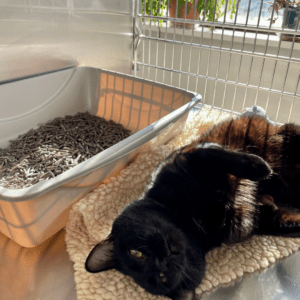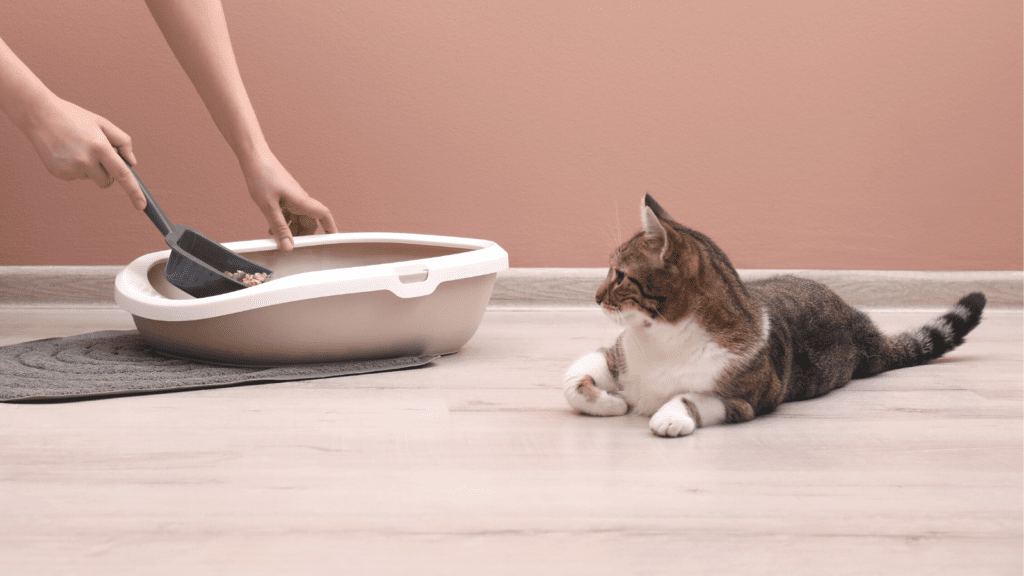Cats who live outdoors, such as community cats or feral cats, obviously don’t use a litter box. But it’s instinctual for cats to bury their feces. Humans have used this natural instinct to our advantage — it’s usually easy and quick to train a cat to use a litter box. But when there’s trouble at the box, it can be a big problem. In fact, a cat not using the litter box is one of the top reasons people consider rehoming their cat.
If your cat isn’t using the litter box, it can get frustrating fast! No one likes cleaning up cat pee. But don’t despair. It may take some sleuthing, but many litter box issues can be resolved. You and your cat will be happier if you follow the tips below.
Before you try anything else, you first want to make sure that the litter box problems aren’t the result of an underlying health issue. Talk with your veterinarian as soon as you notice a problem, especially if your cat was using the litter box well but then stops suddenly. Health issues — including urinary tract infections, anxiety, and even arthritis — can cause your kitty to avoid the litter box.
If your veterinarian has ruled out a medical cause, read on to learn more about how to get your kitty back in the box.
5 Common Reasons Your Cat Isn’t Using the Litter Box
-
- The litter box is covered
Furniture that’s built to hide a litter box is quite popular these days. And it’s tempting to want to use a litter box with a “hood” or other top on it. But we recommend against using a covered litter box. Have you ever noticed a cat jump out of their box after doing their business or dash quickly away? The process of elimination makes cats feel vulnerable, and they naturally want an easy escape route from the litter box. A covered box can make a cat feel cornered and anxious, which can cause them to avoid using it. For senior cats, getting in and out of a high-sided, covered box might be uncomfortable too, so try something uncovered with low sides. - They don’t like the litter
Generally cats prefer litter that mimics what they’d use out in the wild. Something soft and sandy that feels comfortable on their paws is usually best. But every cat has unique preferences. You may need to experiment with a few different types of litter before finding the one your kitty likes and uses consistently. - It’s not clean enough
In general, cats prefer a tidy box. Your kitty doesn’t want to step over and around their old waste. Make sure to scoop or empty the litter box daily. If you’re using a non-clumping litter, aim to do a thorough cleaning and change out all the litter weekly. You’ll want to do this once a month if you use clumping litter. - Too few litter boxes
Some cats prefer to go #1 in one box and #2 in another. Having multiple litter box options also helps alleviate tension in multi-cat households. Cat’s don’t really “hold it in” the way humans do. If a cat needs to go and the only box available is already in use, that cat is more likely to eliminate somewhere else (like your bed, a rug, or on furniture).
How many litter boxes should you have? A good guideline is one litter box for each cat in the home, plus one extra. So for one cat, you’d have two boxes; if you have two cats, you should have three litter boxes, and so on. It may seem excessive, but it’s beat cleaning up cat messes! - The location is off
Most cats prefer a quiet, low-traffic place to do their business, away from their food and water. And just like having multiple boxes helps ease tension among cats, placing those boxes in different locations can reduce stress too. Like humans, a kitty wants to use the bathroom in peace — the vibrating spot next to a loud washing machine usually isn’t the best choice. Place litter boxes in an out-of-way area where your kitty is unlikely to get interrupted by loud noises, humans, or other pets.

Should I Train My Cat to Use a Toilet?
While it might seem convenient, training a cat to use a human toilet is not a great idea. Litter boxes are a much more natural and comfortable place for your cat to go to the bathroom. Even if you succeed in getting your cat to step onto the slippery toilet seat, it only takes one incident (like falling off and into the water) for your cat to stop using the toilet and never go back. It’s much easier to retrain a cat to use a litter box, even if they get an aversion to a certain litter or location. We strongly recommend you avoid toilet training and stick with litter boxes for your cat. They will thank you!
Get creative
Think beyond the box! Sometimes other types of changes can help. This is especially true when litter box aversion is caused by anxiety or tension between cats (even cats who seem to get along great can have relationship issues we humans fail to see).
Recently, a CAT staff member was struggling with their cat defecating outside the litter box. After following all of the typical litter box recommendations (number of boxes, litter type, etc.), their kitty still wasn’t consistently using the box. When the staff member added a second food and water station to their home, it helped ease some of their cat’s anxiety, which resulted in using the box as desired! Cats can display anxiety in unusual ways and the solution to a litter box problem might not always be what you think.
For more solutions to common litter box problems, check out this handy infographic to guide your litter box setup and reference the Litter Box Issues section of our Resource Center.
- The litter box is covered




